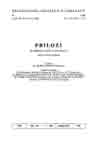Privredna i konfesionalna struktura stanovništva u Hercegovini krajem XVI stoljeća
Economic and Confessional Structure of the Population in Herzegovina at the End of 16th Century
Author(s): Ahmed S. AličićSubject(s): History
Published by: Orijentalni Institut u Sarajevu
Summary/Abstract: The question of economic and confessional structure of the population in Bosnia and Hercegovina, i. e. population structure on the whole under the Ottoman rule is one of the most important questions of the history of Bosnia and Herzegovina. This question has not been studied in the satisfying way for the following reasons: the shortage of the authentic luchiv sources and the fact that these questions have been treated in stereotypic and very often one-sided way, and concerning the economic structure there were mainly emphasized two components - moslem and christian, i.e. all the Moslems were privileged and all the Christians were subdued. We have analyzed these two components in the area of the former sanjak of Herzegovina, on the basis of one authentic archiv source that is detailed register of the farmers of Herzegovina dated in 1585. This register offers clearly defined class structure of the Ottoman society in which productive structure, both Moslems and Non-moslems were exploited. This register also shows that population in Herzegovina at the end of 16tb century was mainly Moslem (85% ). In the same time, it is obvious that all social and economic processes which are characteristic of classical Ottoman system were already finished in our countries in mentioned time. Although the division of Ottoman society on military class as ruling class and reaya as subdued class is generally accepted we have relied upon those classifications based on production character and the activity of all the population in Ottoman Empire. The main economic activity in this system consists of agrarian and cattle-breading production, and also handicraft and commercial activity in towns. According to economic activity we have the following population stuctures: farmers, cattle breeders, craftsmen, and merchants. All the unproductive population is characterized as military. The spreading of Islam in Bosnia and Herzegovina represents one of the most important questions of the history of the people of Bosnia and Herzegovina. This question is not definitively solved as yet. So we are trying to reach the true as close as possible. There are great differences in understanding of this question and also in approuches to it. We cited it in this paper, and for this summary we shall present the most important factors that influenced the spreading of Islam in Bosnia and Hercegovina.
Journal: Prilozi za orijentalnu filologiju
- Issue Year: 1991
- Issue No: 40
- Page Range: 125-192
- Page Count: 68
- Language: Bosnian

